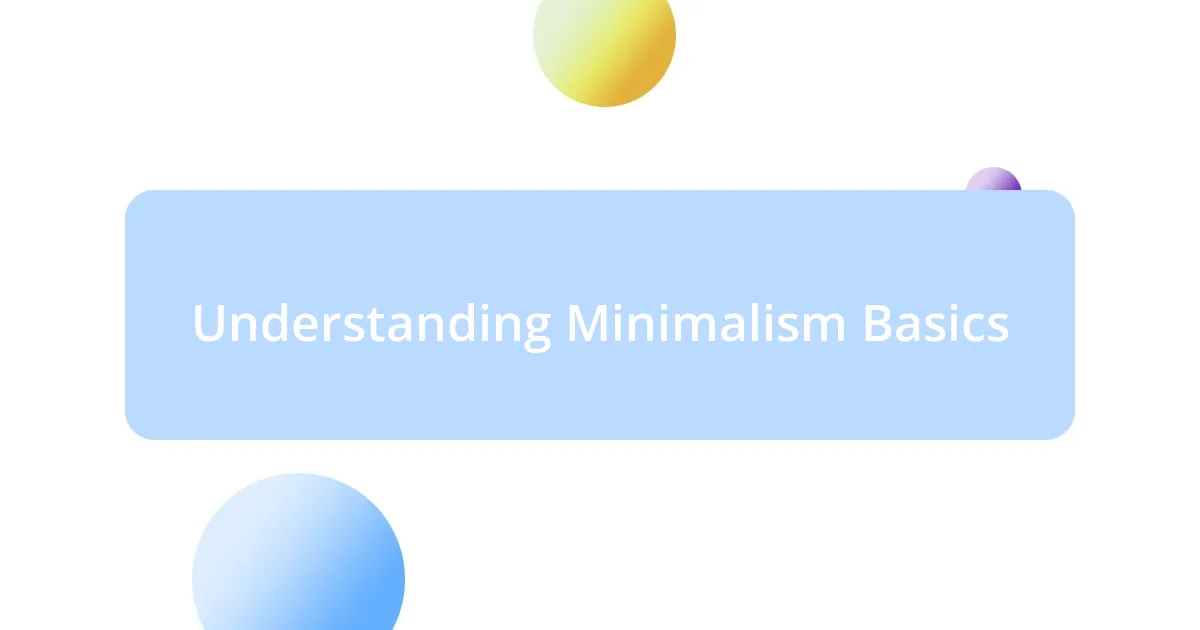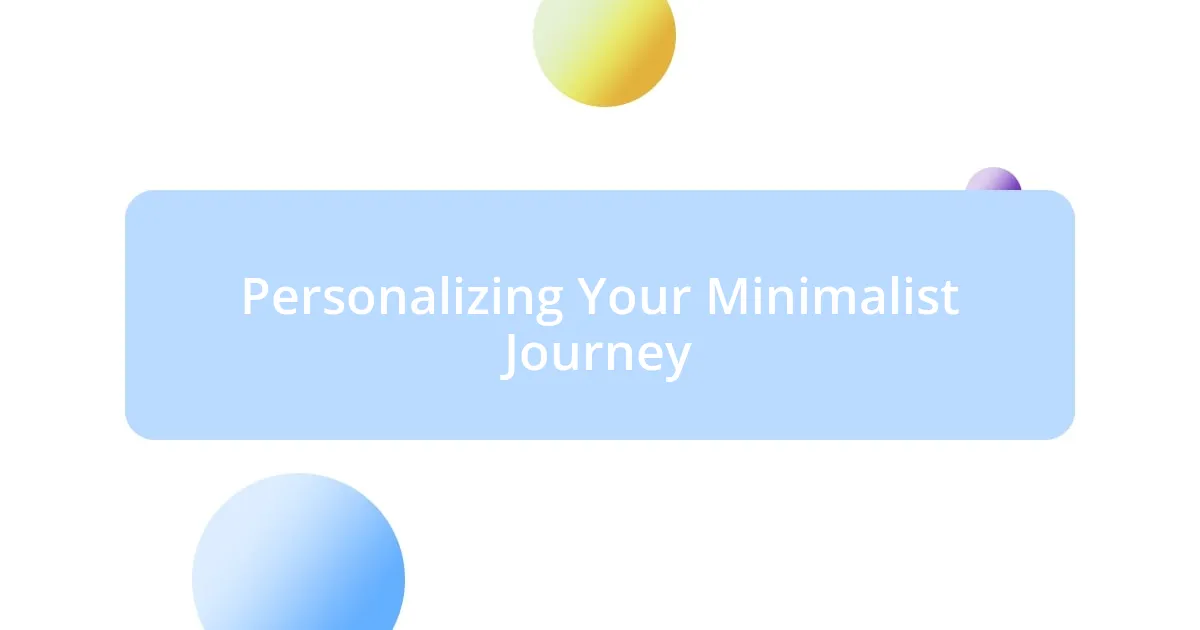Key takeaways:
- Minimalism emphasizes intentionality and prioritizing what truly matters, leading to a liberating sense of clarity and focus.
- Decluttering your space can transform your environment and mindset, enhancing feelings of freedom and appreciation for what you keep.
- Mindfulness complements minimalism by encouraging the savoring of each moment, promoting well-being and clarity of thought.
- Sustainable minimalism involves mindful consumption, such as the “one in, one out” rule and thrift shopping, to cultivate a meaningful and fulfilling lifestyle.

Understanding Minimalism Basics
Minimalism is about simplifying life by removing excess—not just in physical possessions but also in mental clutter. I remember my parents’ home overflowing with trinkets and decorations. Every time I visited, I felt a sense of chaos. Can you relate? This feeling often creeps in when our spaces are cluttered, reminding me of the profound peace that openness can bring.
At its core, minimalism is about intentionality. Personally, I’ve learned that choosing what to keep requires me to evaluate my priorities and values. When I decided to part with items that didn’t serve a clear purpose, it felt liberating—almost like shedding a weight I didn’t realize I was carrying. Have you ever sorted through your belongings and found unexpected joy in letting go?
Ultimately, minimalism encourages a mindful approach to consumption. It’s not always about having less but rather about cherishing more. Like when I opted for experiences over things; attending a concert instead of buying a new gadget shifted my happiness significantly. Isn’t it fascinating how often our choices can lead us closer to fulfillment?

Benefits of Adopting Minimalism
Adopting minimalism has profoundly enriched my life in unexpected ways. One of the most noticeable benefits is the immense clarity and focus I’ve gained. With fewer distractions around me, I find it easier to concentrate on what truly matters. I remember the day I cleared out my closet, removing clothes I hadn’t worn in years. The moment I closed the door to that newly organized space, I felt a refreshingly light sense of control wash over me. It’s a subtle yet empowering shift that I cherish daily.
Here are some key benefits I’ve experienced by embracing minimalism:
- Reduced Stress: Less clutter means fewer decisions and distractions, which can lead to a calmer mindset.
- Increased Productivity: I’ve found that with a simplified environment, my ability to focus and accomplish tasks improves significantly.
- Financial Savings: By consciously choosing to buy only what I need, I’ve managed to save money and invest in experiences rather than things.
- Enhanced Relationships: Minimalism has encouraged me to engage more fully with friends and family, prioritizing quality time over material possessions.
- Greater Appreciation: I now genuinely value the items I choose to keep and the experiences I pursue, leading to deeper satisfaction.
The journey toward minimalism often invites a sense of freedom that I never anticipated. I sometimes wonder if this lifestyle shift was a hidden treasure waiting to be discovered, shifting my priorities in a way that brings genuine happiness. Wouldn’t you agree that letting go of the unnecessary allows room for the truly fulfilling?

Decluttering Your Living Space
Decluttering your living space is an essential step in embracing minimalism. I vividly recall the first time I tackled my living room. I spent an entire Saturday sorting through books, knick-knacks, and old magazines. The process felt strangely therapeutic, transforming my once chaotic environment into a serene oasis. Have you ever felt the freedom that comes with a clean slate?
I believe the key to effective decluttering lies in establishing a system that works for you. When I started categorizing items into keep, donate, and discard, it became so much easier to let go of things I hadn’t used in years. This method not only streamlined the process but also made me more mindful of what I chose to keep. As I filled boxes for donation, I experienced a bittersweet rush of nostalgia mixed with relief. It reminded me that memories don’t reside in objects, but within ourselves.
After decluttering my space, I noticed profound changes. My home felt larger, lighter, and filled with possibilities. I began to enjoy aspects of my home that I had previously overlooked, like the natural light pouring through my windows. It’s remarkable how much our surroundings can influence our mindset. Have you ever reflected on how your environment shapes your day-to-day emotions? I find that a clutter-free space often leads to a clutter-free mind.
| Item Category | Action |
|---|---|
| Clothes | Donate or recycle items not worn in the last year |
| Books | Keep only those that inspire or bring joy |
| Knick-knacks | Evaluate emotional attachment before keeping |
| Furniture | Consider functionality and space |
| Sentimental items | Limit to a small box for cherished memories |

Simplifying Your Daily Routine
Simplifying my daily routine has been a transformative experience. I started by reducing the number of tasks I felt I had to do each day. Now, I prioritize what truly adds value to my life. For instance, I used to spend time planning elaborate meals. Instead, I embraced meal prepping and simple recipes I actually enjoy. It’s astonishing how much time I reclaim, all while eating well!
By focusing on only essential tasks, I allow myself the mental space to engage in what matters. I remember feeling overwhelmed on busy mornings—trying to juggle breakfast, outfits, and a packed schedule made me anxious. Now, I set out my clothes the night before and stick to a quick morning routine. It feels liberating! Have you ever considered how much easier life could be with just a little planning ahead?
I also learned the importance of saying “no” to unnecessary commitments. Initially, the thought of declining invitations made me anxious. Yet, saying “no” allowed me to preserve my energy for meaningful relationships and personal projects. Now, I relish my free time. It’s like breathing fresh air. I find those quiet moments rejuvenating, and I ask—what could you do with that newly found time for yourself?

Mindfulness and Minimalism Connection
Mindfulness and minimalism are deeply intertwined for me. When I embraced minimalism, I didn’t just clear out my items—I also cleared out mental clutter. I remember sitting in my living room, surrounded by only the essentials, and experiencing a sense of peace I hadn’t felt in ages. It made me acutely aware of the present moment, allowing me to enjoy the simple pleasure of a cup of tea without distractions. Have you ever paused to appreciate something as simple as your favorite drink in silence?
Practicing mindfulness while living minimally has transformed my perspective on well-being. I began to savor my daily experiences instead of rushing through them. For instance, during my morning walks, I intentionally focus on each step, feeling the ground beneath my feet and the breeze on my skin. It’s a grounding practice that keeps me anchored. I’ve noticed that when my surroundings are uncluttered, my thoughts become clearer, making each step feel like a meditative moment. Have you experienced the tranquility that comes from just being in the moment?
The connection between mindfulness and minimalism is truly profound. When I let go of unnecessary possessions, I also released the weight of expectations and judgments I placed on myself. I realized that the less I owned, the more space I had to explore my thoughts and feelings. Recently, I found myself in a situation where I had to choose between an old item with memories attached and my new-found freedom. Choosing to let go reminded me that life is about experiences, not possessions. It made me question what truly matters. What would you let go of to make room for more meaningful moments?

Tips for Sustainable Minimalism
Embracing sustainable minimalism has taught me to truly assess the quality of my belongings. I remember the day I opened my closet and realized I had items I hadn’t worn in years, mostly just hanging there, stuffed and forgotten. It hit me—what if I curated my wardrobe around versatile, high-quality pieces that I genuinely love? Since making this shift, I feel more confident and make better fashion choices, often sparking the question: How can you build a collection that reflects who you are while being sustainable?
Sustainability is also about mindful consumption. I’ve started to enjoy thrift shopping, where I can find unique items with a history, rather than succumbing to fast fashion. Last summer, I stumbled upon a vintage jacket that spoke to me—its soft fabric felt like a warm hug. Knowing it had its own story adds depth to my wardrobe and reminds me that every item I choose can be meaningful. Have you thought about the incredible stories behind pre-loved treasures?
Another tip I swear by is the “one in, one out” rule. Every time I buy something, I commit to letting go of another item. This habit forces me to weigh the need for new purchases against what I already own. I recall a moment when I felt tempted to get a shiny new gadget. Instead, I decided to sell my old one online. Not only did I make space in my life, but I also earned some extra cash, reinforcing the idea that sustainability can be rewarding in multiple ways. What could you part with to feel lighter and more fulfilled?

Personalizing Your Minimalist Journey
Personalizing your minimalist journey is all about understanding your unique relationship with your possessions. I think back to when I first started decluttering; every item I touched reminded me of past moments. It was emotional, but choosing to keep only what truly resonated with me was liberating. Have you ever found something that brought back memories, only to realize it was more a burden than a blessing?
As I tailored my minimalist approach, I discovered that my home reflects my values and passions. For example, my living space now showcases art that inspires me, instead of a cluttered shelf of decorative items that I never connected with. I remember a time when I displayed random souvenirs from trips, thinking they would bring joy. Now, though, I have only a couple of pieces that spark genuine happiness. What would your space say about you if you stripped away everything that didn’t resonate?
Throughout this journey, I’ve learned that personalizing minimalism also means creating spaces that serve me best. I transformed my office into a serene workspace by introducing plants and natural light, which has made such a difference in my productivity. Reflecting on it, I often wonder: how do your surroundings affect your mindset? Investing time into curating your space is key; it can foster an environment that nurtures creativity and clarity while keeping distractions at bay.












